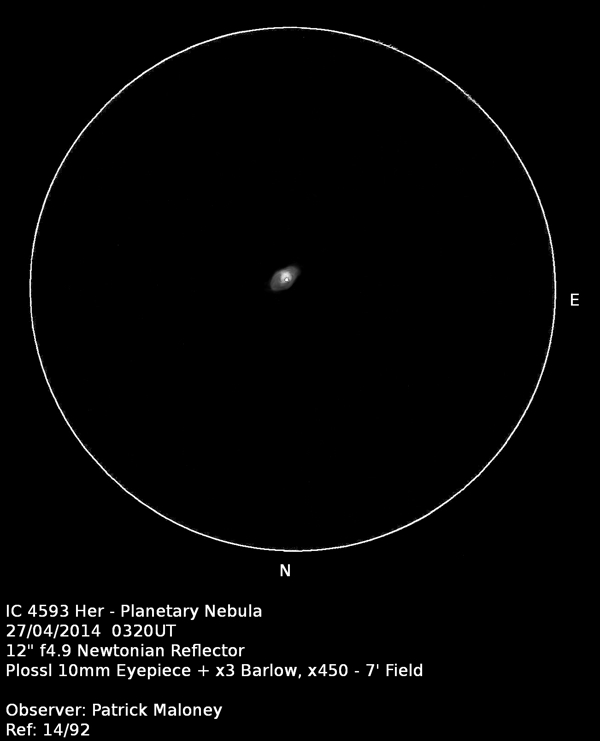IC 4593 in Hercules
May 2022 - Nebula and Cluster of the Month
May brings with it, we hope, warmer weather and the real promise of sunny days. What is more certain is that for those of us in northern temperate zones it brings the end of astronomical darkness for some weeks to come. The centre of Britain sees astronomical darkness for only 22 minutes on the night of 12/13 May. The following night there is none, and it will not be seen again until 31 July, when we get 26 minutes.
The occurrence of astronomical darkness is these days more theoretical than practical. Most of us live all year under perpetual artificial twilight, so we should be used to dealing with it, and unless you live in the far north, you really have no excuse for putting the telescope in storage for 10 weeks.
This month, then, we’re going to concentrate on an object that is easy to see, even under twilight, but can be difficult to pick out in a low-power field. High power is needed to get the best view.
May’s object is a small planetary nebula in Hercules, IC 4593. It is very bright – magnitude 10.7 – so should be easily seen by all but the smallest telescopes. Recognising it for what it is will require higher power.

It was discovered on Harvard photographic plates by Williamina Fleming in 1907 and bears her designation Fleming 108. The entry in the Index Catalogue is typically terse: Planetary, stellar
.
NASA quotes a distance for IC 4593 of between 7000 and 8000 light-years (2150 - 2450pc), though other estimates range from 3000 to 12000 light-years. Assuming a diameter of one light-year (about average for a planetary nebula), the distance should be about 5000 light-years. Planetary nebulae distances and diameters are notoriously uncertain.
Images of the nebula show a bright inner region and a much fainter, much larger outer envelope. The object also displays what appear to be bipolar jets with brighter blobs of material at the ends, which look very similar to the famous ‘ansae’ (Latin; ‘handles’) of NGC 7009.
In 2012, observations made with the Chandra X-Ray telescope led to the discovery of a ‘hot bubble’ around the central star of IC 4593 (Monthly Notices of the Royal Astronomical Society, Volume 494, Issue 3, May 2020, Pages 3784–3789). This is not the only hot bubble detected in a planetary nebula by Chandra, but is so far the most distant.
IC 4593 is not the easiest object to locate. It lies in the southwest of Hercules, close to the border with Serpens, in a relatively barren region of sky.
The brighter central part, which is all that you’re going to see visually, is about 29” in diameter. The central star, of spectral type O0, is magnitude 11, and easily visible, and can be well seen in low finding powers. You may have to inspect a few stars in the field on high power before picking out the right one. Some observers of planetary nebulae can pick out a stellar planetary nebula even with low power. There’s something about the quality of the light from these objects that draws the eye. I’ve found this to be so on several occasions. This is a good one to test the effect out on.

High power reveals a circular bright disc, with an elongated outer envelope (not the really faint one visible in images) that stretches away from the bright inner part like wings. I found that the object was still stellar at x83, but when I cranked the magnification up to x450, a fair amount of detail could be seen. To my eyes, the effect of the OIII filter was marginal. At high power, the object is isolated in the field with no visible field stars. There is a 9.4 magnitude star 5’ to the northwest, just outside my high-power field. In common with several other observers, I see a very clear blue colour in this object. The bright central star appeared to be oddly off-centre.
| Object | RA | Dec | Type | Magnitude |
|---|---|---|---|---|
| IC 4593 | 16h 11m 44s | +12° 04’ 17” | Planetary nebula | 10.7 |